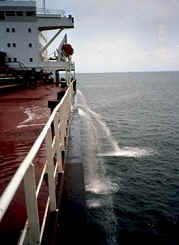Researchers made a conservative estimate that between 1900 and 1999 around 2.9 million whales were killed by the whaling industry. The hunting was spread across sperm, fin, humpback, sei, blue, minke, and other whale species. The data shows that, before human influences, oceans had the capacity to support a large number of whales. Although 2.9 million seems like a drastic number, the whaling industry was extremely efficient in the 20th century with the introduction of diesel engines and exploding harpoons. Scientist believe that there were even more whales that were captured or wounded that were not recorded. Read more...
-----------------------------------------------
2. Cyclops Submersible Brings Deep-Water Exploration to the 21st Century

OceanGate recently unveiled a new manned submersible built for scientific exploration. The submersible, named Cyclops, has the capability to take 3 to 4 researchers to a depth of 20,000 feet. There is some debate on whether or not it is beneficial to send humans to those dangerous depths as opposed to drones. Erica Montague, Director of Science and Technology at OceanGate states, " the most powerful resource we have for ocean exploration is our brain". Read more...
-----------------------------------------------
3. Rare 475 Pound Sea Turtle Rescued

Last weekend a leatherback sea turtle was found off of the coast of South Carolina. The turtle, named “Yawkey” by the associates at the SC Aquarium, did not see any signs of trauma and gave it antibiotics and vitamins to recover. Although this is an extremely large turtle, this species can actually grow up to 2,000 pounds. Yawkey is currently resting and gaining strength for his upcoming release back into the ocean. Read more...
-----------------------------------------------
4. No, Cosmic Rays Aren't Causing Global Warming
According to a study published in the Proceedings of the National Academy of Sciences, the amount of cosmic rays dose does not have long term impacts that would have lead to the 20th century climate change. Cosmic rays are the energized particles from outerspace that interact with our atmosphere. Scientists reviewed both short term and long term data on temperature vs. amount of cosmic rays to come to their overall conclusions. Read more...
-----------------------------------------------
Take one second and imagine a fish that is 6.5ft across and 15ft long. Not able to? A giant freshwater stingray was found in Thailand's Mae Klong River at those exact dimensions. This species is considered endangered by the International Union for the Conservation of Nature. Although these massive fish are not getting caught in fishing gear, they have been threatened by water pollution and habitat damage. Read more...
-----------------------------------------------
6. Think Man-Sized Swimming Centipede- And Be Glad It's A Fossil
After reviewing a fossil, paleontologists have discovered evidence of the largest arthropod recorded. This species lived 480 million years ago and resembled a 7-foot lobster without claws. Peter van Roy, a paleontologist from Yale, concluded that this anomalocaridid was a filter feeder, similar to whales today. His complete analysis and conclusions of the fossil can be found in the article in Nature here ...
-----------------------------------------------
7. Nearly 200,000 'New' Marine Species Turn Out to be Duplicates

The World Register of Marine Species has determined that 190,400 new sea creatures that were discovered since 2008 are actually redundant. The actual count of new species is 228,445. To read more about the confusion take a look at the site here...
-----------------------------------------------
This week, the Italian company that owned the M/T Marigola was fined for the illegal disposal of waste into the ocean. The ship was caught at the Port of Tampa. Disregarding the APPS regulations, the ship discharged their oil-contaminated waste overboard without using the correct pollution prevention equipment. Read more...
-----------------------------------------------
9. Doubling Down on California's Marine Sanctuaries
This week the NOAA announced the expansion of Gulf of the Farallones and Cordell Bank national marine sanctuaries. This addition will incorporate and additional 2,770 square miles of water. These bodies of water are home to 25 endangered species, 36 marine mammals, great white sharks, and a number of seabirds. Read more...
-----------------------------------------------
10. Mystery of Male Swordfish Courtship Ritual Revealed
 Can't say that I've really ever thought about this question but, how do swordfish mate? After years of mystery around this topic, scientist recently found the answer! Scientists Jaime Mejuto and Blanca Garcia-Cortes were the first able to capture the courting of these fish. To read the complete reproductive process and see the pictures click here...
Can't say that I've really ever thought about this question but, how do swordfish mate? After years of mystery around this topic, scientist recently found the answer! Scientists Jaime Mejuto and Blanca Garcia-Cortes were the first able to capture the courting of these fish. To read the complete reproductive process and see the pictures click here...
-----------------------------------------------
Be sure to "LIKE" http://facebook.com/SeaSave to ensure our "Week in Review" is delivered to your newsfeed every Thursday.
Sea Save Foundation is committed to raising awareness of marine conservation. The Week in Review is a team effort produced by the Sea Save staff to provide a weekly summary of the latest in marine research, policy, and news.





